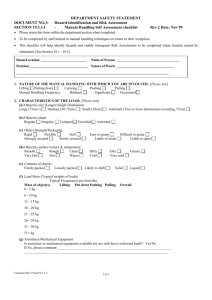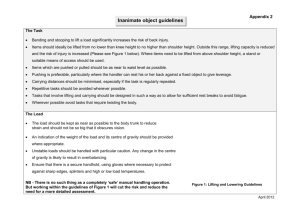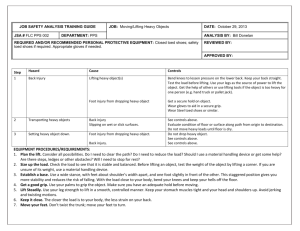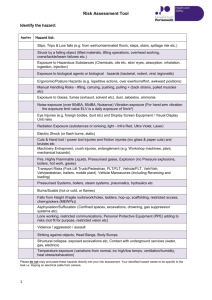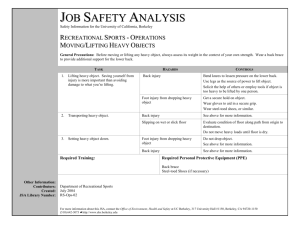18.4 Manual Handling
advertisement
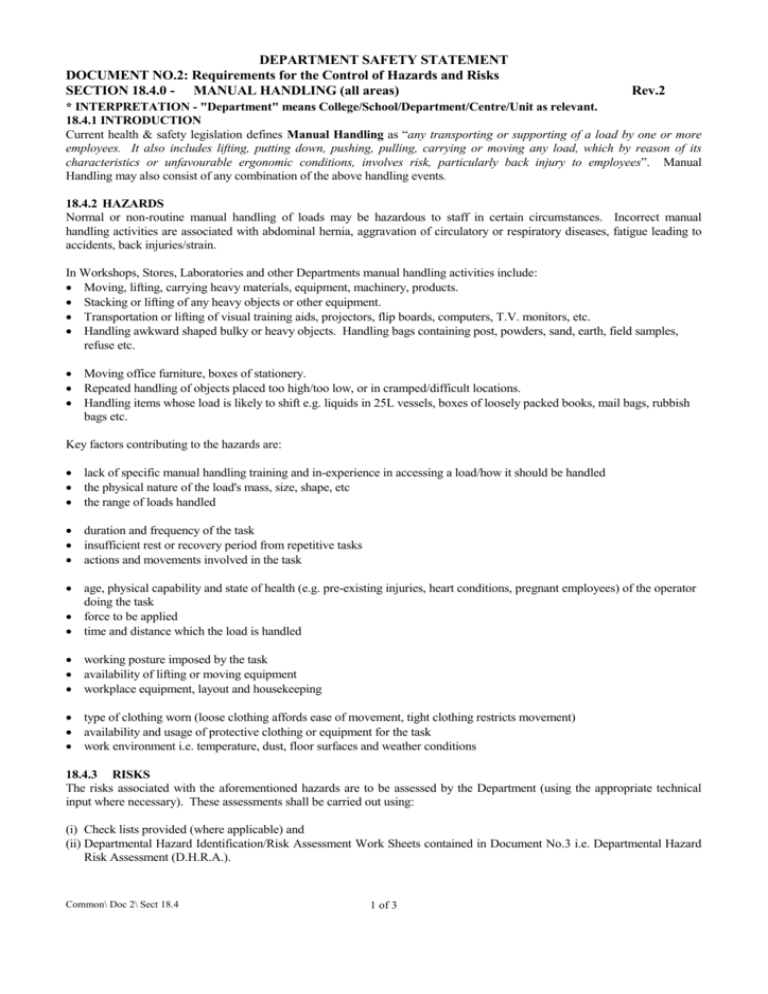
DEPARTMENT SAFETY STATEMENT DOCUMENT NO.2: Requirements for the Control of Hazards and Risks SECTION 18.4.0 - MANUAL HANDLING (all areas) Rev.2 * INTERPRETATION - "Department" means College/School/Department/Centre/Unit as relevant. 18.4.1 INTRODUCTION Current health & safety legislation defines Manual Handling as “any transporting or supporting of a load by one or more employees. It also includes lifting, putting down, pushing, pulling, carrying or moving any load, which by reason of its characteristics or unfavourable ergonomic conditions, involves risk, particularly back injury to employees”. Manual Handling may also consist of any combination of the above handling events. 18.4.2 HAZARDS Normal or non-routine manual handling of loads may be hazardous to staff in certain circumstances. Incorrect manual handling activities are associated with abdominal hernia, aggravation of circulatory or respiratory diseases, fatigue leading to accidents, back injuries/strain. In Workshops, Stores, Laboratories and other Departments manual handling activities include: Moving, lifting, carrying heavy materials, equipment, machinery, products. Stacking or lifting of any heavy objects or other equipment. Transportation or lifting of visual training aids, projectors, flip boards, computers, T.V. monitors, etc. Handling awkward shaped bulky or heavy objects. Handling bags containing post, powders, sand, earth, field samples, refuse etc. Moving office furniture, boxes of stationery. Repeated handling of objects placed too high/too low, or in cramped/difficult locations. Handling items whose load is likely to shift e.g. liquids in 25L vessels, boxes of loosely packed books, mail bags, rubbish bags etc. Key factors contributing to the hazards are: lack of specific manual handling training and in-experience in accessing a load/how it should be handled the physical nature of the load's mass, size, shape, etc the range of loads handled duration and frequency of the task insufficient rest or recovery period from repetitive tasks actions and movements involved in the task age, physical capability and state of health (e.g. pre-existing injuries, heart conditions, pregnant employees) of the operator doing the task force to be applied time and distance which the load is handled working posture imposed by the task availability of lifting or moving equipment workplace equipment, layout and housekeeping type of clothing worn (loose clothing affords ease of movement, tight clothing restricts movement) availability and usage of protective clothing or equipment for the task work environment i.e. temperature, dust, floor surfaces and weather conditions 18.4.3 RISKS The risks associated with the aforementioned hazards are to be assessed by the Department (using the appropriate technical input where necessary). These assessments shall be carried out using: (i) Check lists provided (where applicable) and (ii) Departmental Hazard Identification/Risk Assessment Work Sheets contained in Document No.3 i.e. Departmental Hazard Risk Assessment (D.H.R.A.). Common\ Doc 2\ Sect 18.4 1 of 3 DOCUMENT NO.2: Requirements for the Control of Hazards and Risks SECTION 18.4.0 - MANUAL HANDLING (Cont.) Rev.2 18.4.4 ARRANGEMENTS AND CONTROLS REQUIRED These hazards and risks will be minimised by the following arrangements and controls: All staff will have been trained in safe manual handling techniques, specific to their tasks, using competent trainers. Risk assessments must be carried out covering the factors outlined above by using the self-assessment form in Document 3, Section 19.3.3.1. The design of the workplace and work tasks to eliminate the necessity for lifting whenever possible and to minimise significant body motions (e.g. bending, twisting, reaching out) and to reduce object weights/forces (lifting, lowering, pushing, pulling and carrying forces). When practicable, the lifting and carrying of loads should be reduced by the use of mechanical aids e.g. raised work levels, lift tables etc. or reducing weight. Suitable grips or handles to provide access to load or convert movement to pushing or pulling. Where practicable, Pulling and Pushing forces should be reduced by use of mechanical aids e.g. rollers, hand or powers trolleys and by reducing the distance moved by improving or re-locating storage layouts. Where practicable, carrying forces could be reduced by pushing or pulling by use of conveyors, trolleys, trucks etc. or by reducing load and distance carried. Where practicable, holding forces may be reduced by reducing the size or weight of a load, use of stable props/tables/trestles. Loads should be assessed for weight, size, shape, condition and stability before transportation or movement. The personal characteristics of the employee e.g. capability, age, history of previous back injury will be taken into account. Personal protective clothing shall be provided and used, if required. Two or more persons will be utilised to lift loads in excess of 25kg. Supervisors will ensure safe manual handling methods are utilised by staff by ensuring that: Excessive lifting, lowering or carrying distances are eliminated. Staff are not involved in over-frequent or prolonged physical effort involving the spine. There are sufficient bodily rest and recovery periods. The employee can control the rate of work. A guide person shall be utilised to guide any teams lifting furniture up/down stairs. The internal work environment must in so far as it is reasonably practicable, be free of the following hazards: 1. Uneven or slippery floors and walking surfaces of in poor condition. 2. Obstructions and different floor levels. 3. Poor housekeeping practices. 4. Inadequate lighting. 5. Extremes of heat, cold, wind and humidity. 6. Excessive vibration or noise. 7. Tasks that require to be performed in confined space (such as lifting or applying force). 18.4.4.1 SAFE LIFTING BY MECHANICAL MEANS: There are times when, to ensure safety, the manual-handling task is replaced by mechanical aids. Safe lifting by mechanical methods needs to be planned. Any equipment you use must have been properly designed manufactured and tested. Points to Consider: What you are lifting, Its weight, Its centre of gravity, How to attach it to the lifting machinery, Who is in control of the lift, The safe limits of the equipment, Common\ Doc 2\ Sect 18.4 2 of 3 DOCUMENT NO.2: Requirements for the Control of Hazards and Risks SECTION 18.4.0 - MANUAL HANDLING (Cont.) 18.4.4.1 Rev.2 SAFE LIFTING BY MECHANICAL MEANS (Cont.): Also Rehearsing lifts if necessary. Use only certified lifting equipment, marked with its safe working load, which is not overdue for examination. Keep the test certificate for all lifting machinery and tackle showing its safe working load, and the annual or six-monthly examination reports. Never use unsuitable equipment, e.g. makeshift, damaged, badly worn chains shortened with knots, kinked or twisted wire ropes, frayed or rotted fibre robes. Never exceed the safe working load of machines or tackle. Remember that the load in the legs of a sling increases as the angle between the legs increase. Do not lift a load if you doubt its weight or the adequacy of the equipment. Make sure the load is properly attached to the lifting equipment. If necessary, securely bind the load to prevent it slipping or falling off. Before lifting an unbalanced load, find out its centre of gravity. Raise it a few inches off the ground and pause - there will be little harm if it drops. Use packing to prevent sharp edges of the load from damaging slings and do not allow tackle to be damaged by being dropped, dragged from under loads or subjects to sudden loads. When using jib cranes, make sure the load radius indicator and/or automatic safe load indicator is correctly set both for the job to be carried out and the set up of the crane. Outriggers should be used where necessary. When using multi-slings, make sure the sling angle is taken into account. Have a responsible slinger or banksman and use a recognised signalling system. The item of equipment, sling or aid must be kept in a good condition and regularly maintained. 18.4.5 ARRANGEMENTS AND CONTROLS The details of the Arrangements and Controls in place and those required in the short, medium and long term, shall be set out by the Department in the forms provided in Document No.4 i.e. Departmental Safety Action Plan (D.S.A.P.). These Arrangements and Controls shall be reviewed and updated on a yearly basis. 18.4.6 RESPONSIBILITIES The following personnel are responsible in the Department/Lab/Area for ensuring the implementation and ongoing compliance with the aforementioned arrangements and controls. AREA/LOCATION PERSON RESPONSIBLE 1. 2. 3. 4. 5. 6. Common\ Doc 2\ Sect 18.4 3 of 3
